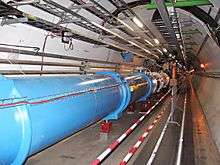Tetraquark
| Standard Model of particle physics |
|---|
 Large Hadron Collider tunnel at CERN |
|
Scientists Rutherford · Thomson · Chadwick · Bose · Sudarshan · Koshiba · Davis Jr. · Anderson · Fermi · Dirac · Feynman · Rubbia · Gell-Mann · Kendall · Taylor · Friedman · Powell · P. W. Anderson · Glashow · Meer · Cowan · Nambu · Chamberlain · Cabibbo · Schwartz · Perl · Majorana · Weinberg · Lee · Ward · Salam · Kobayashi · Maskawa · Yang · Yukawa · 't Hooft · Veltman · Gross · Politzer · Wilczek · Cronin · Fitch · Vleck · Higgs · Englert · Brout · Hagen · Guralnik · Kibble · Ting · Richter |
A tetraquark, in particle physics, is an exotic meson composed of four valence quarks. In principle, a tetraquark state may be allowed in quantum chromodynamics, the modern theory of strong interactions. Any established tetraquark state would be an example of an exotic hadron which lies outside the quark model classification.
History

In 2003 a particle temporarily called X(3872), by the Belle experiment in Japan, was proposed to be a tetraquark candidate,[2] as originally theorized.[3] The name X is a temporary name, indicating that there are still some questions about its properties to be tested. The number following is the mass of the particle in MeV/c2.
In 2004, the DsJ(2632) state seen in Fermilab's SELEX was suggested as a possible tetraquark candidate.
In 2007, Belle announced the observation of the Z(4430) state, a
c
c
d
u
tetraquark candidate. There are also indications that the Y(4660), also discovered by Belle in 2007, could be a tetraquark state.[4]
In 2009, Fermilab announced that they have discovered a particle temporarily called Y(4140), which may also be a tetraquark.[5]
In 2010, two physicists from DESY and a physicist from Quaid-i-Azam University re-analyzed former experimental data and announced that, in connection with the
ϒ
(5S) meson (a form of bottomonium), a well-defined tetraquark resonance exists.[6][7]
In June 2013, the BES III experiment in China and the Belle experiment in Japan independently reported on Zc(3900), the first confirmed four-quark state.[8]
In 2014, the Large Hadron Collider experiment LHCb confirmed the existence of the Z(4430) state with a significance of over 13.9 σ.[9][10]
In February 2016, the DØ experiment announced the observation of a narrow tetraquark candidate, named X(5568), decaying to Bsπ±.[11] However, preliminary results from LHCb, presented at the 51st Rencontres de Moriond Electroweak session, show no evidence for the state, despite a much larger sample of
B0
sπ± candidates.[12]
In June 2016, LHCb announced the discovery of three additional tetraquark candidates, called X(4274), X(4500) and X(4700).[13][14][15]
See also
References
- ↑ N. Cardoso; M. Cardoso; P. Bicudo (2011). "Colour Fields Computed in SU(3) Lattice QCD for the Static Tetraquark System". Physical Review D. 84 (5): 054508. arXiv:1107.1355
 . Bibcode:2011PhRvD..84e4508C. doi:10.1103/PhysRevD.84.054508.
. Bibcode:2011PhRvD..84e4508C. doi:10.1103/PhysRevD.84.054508. - ↑ D. Harris (13 April 2008). "The charming case of X(3872)". Symmetry Magazine. Retrieved 2009-12-17.
- ↑ L. Maiani; F. Piccinini; V. Riquer; A.D. Polosa (2005). "Diquark-antidiquarks with hidden or open charm and the nature of X(3872)". Physical Review D. 71 (1): 014028. arXiv:hep-ph/0412098
 . Bibcode:2005PhRvD..71a4028M. doi:10.1103/PhysRevD.71.014028.
. Bibcode:2005PhRvD..71a4028M. doi:10.1103/PhysRevD.71.014028. - ↑ G. Cotugno; R. Faccini; A.D. Polosa; C. Sabelli (2010). "Charmed Baryonium". Physical Review Letters. 104 (13): 132005. arXiv:0911.2178
 . Bibcode:2010PhRvL.104m2005C. doi:10.1103/PhysRevLett.104.132005.
. Bibcode:2010PhRvL.104m2005C. doi:10.1103/PhysRevLett.104.132005. - ↑ A. Minard (18 March 2009). "New Particle Throws Monkeywrench in Particle Physics". Universe Today. Retrieved 2014-04-12.
- ↑ Z. Matthews (27 April 2010). "Evidence grows for tetraquarks". Physics World. Retrieved 2014-04-12.
- ↑ A. Ali; C. Hambrock; M.J. Aslam (2010). "Tetraquark Interpretation of the BELLE Data on the Anomalous Υ(1S)π+π- and Υ(2S)π+π- Production near the Υ(5S) Resonance". Physical Review Letters. 104 (16): 162001. arXiv:0912.5016
 . Bibcode:2010PhRvL.104p2001A. doi:10.1103/PhysRevLett.104.162001.
. Bibcode:2010PhRvL.104p2001A. doi:10.1103/PhysRevLett.104.162001. - ↑ E. Swanson (2013). "Viewpoint: New Particle Hints at Four-Quark Matter". Physics. 6: 69. Bibcode:2013PhyOJ...6...69S. doi:10.1103/Physics.6.69.
- ↑ C. O'Luanaigh (9 Apr 2014). "LHCb confirms existence of exotic hadrons". CERN. Retrieved 2016-04-04.
- ↑ R. Aaij; et al. (LHCb collaboration) (2014). "Observation of the resonant character of the Z(4430)− state". Physical Review Letters. 112. arXiv:1404.1903
 . Bibcode:2014PhRvL.112v2002A. doi:10.1103/PhysRevLett.112.222002.
. Bibcode:2014PhRvL.112v2002A. doi:10.1103/PhysRevLett.112.222002. - ↑ V. M. Abazov; et al. (DØ collaboration) (2016). "Observation of a new
B0
sπ± state". arXiv:1602.07588 [hep-ex].
[hep-ex]. - ↑ J. van Tilburg (13 March 2016). "Recent hot results & semileptonic b hadron decay" (PDF). CERN. Retrieved 2016-04-04.
- ↑ Announcement by LHCb
- ↑ R. Aaij; et al. (LHCb collaboration) (2016). "Observation of J/ψφ structures consistent with exotic states from amplitude analysis of B+→J/ψφK+ decays". arXiv:1606.07895
 [hep-ex].
[hep-ex]. - ↑ R. Aaij; et al. (LHCb collaboration) (2016). "Amplitude analysis of B+→J/ψφK+ decays". arXiv:1606.07898
 [hep-ex].
[hep-ex].
External links
- The Belle experiment (press release)
- O'Luanaigh, Cian. "LHCb confirms existence of exotic hadrons". cern.ch. Geneva, Switzerland: CERN. Retrieved 2014-04-12.